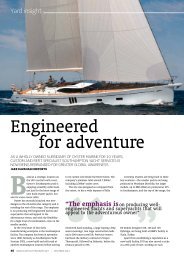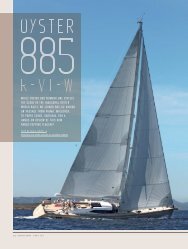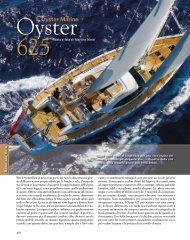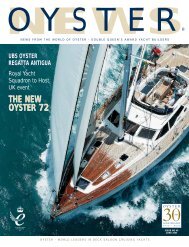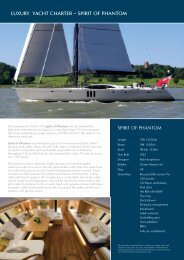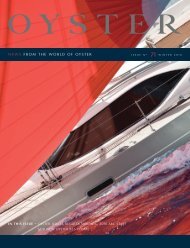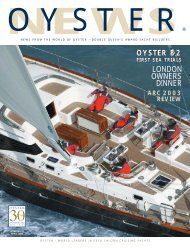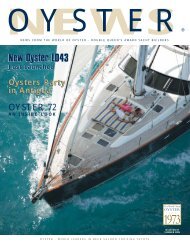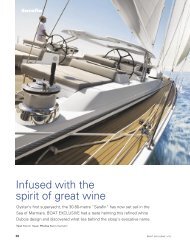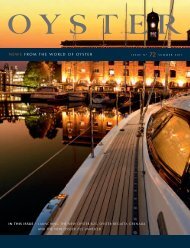Download PDF - Oyster News 66 - Oyster Yachts
Download PDF - Oyster News 66 - Oyster Yachts
Download PDF - Oyster News 66 - Oyster Yachts
You also want an ePaper? Increase the reach of your titles
YUMPU automatically turns print PDFs into web optimized ePapers that Google loves.
Coron<br />
On arrival in Coron we left the province of Visayas. Coron Island is part of the Calamian<br />
Group and offers similar beauty to the neighbouring world-renowned Palawan, for its<br />
vertical limestone formations - although the Corons’ are more concentrated and on a<br />
much smaller scale.<br />
The entrance to our anchorage was very adventurous. Between precipitously sloped<br />
limestone rocks and water varying in different blue to turquoise colours, we found just<br />
enough water to get Moana into the small space. We were in the midst of a stony upright<br />
surrounding! Due to the limestone bottom the anchor would not dig in, so Moana was held<br />
only by the weight of anchor and chain. At that time of the year, the weather conditions were<br />
moderate so we had no concerns. The place was idyllic, impressive and quiet and we<br />
enjoyed the very clear and clean water in this Philippine fjord!<br />
"Take nothing but pictures, leave nothing but footprints, keep nothing but memories, kill<br />
nothing but time" a sign said before we climbed up the stairs to Kayangan Lake. After a rise<br />
and a descent we reached the clear freshwater lake with its three arms nestled into the<br />
limestone of Coron Island. The steep, sharp-edged rock walls are reflected in the clear plain<br />
water. We paddled along the shore of this lake that lays 80 metres above sea level.<br />
We experienced the scenery of Kayangan as sole visitors, the silence was only interrupted<br />
by the humming of our kayak pilot.<br />
Back at sea level we found out that this lake and its surroundings still belong to the<br />
Tagbanuas tribe and therefore is custom ground. All income goes directly to the Tagbanuas.<br />
Even with some income these people live a very simple life. Their houses are built directly on<br />
shore, on stilts and have no flowing water or electricity. They gain additional income by<br />
collecting swallows’ nests. The soup made in Chinese restaurants from these nests is a<br />
delicacy. To prepare one soup requires about 300 nests! The nest contains a protein which is<br />
the main ingredient of the soup. Of course, to collect the nest is not easy. The swallows build<br />
their nests in inaccessible caves on vertical face walls. But Tagbanuas set up a bamboo<br />
construction and climb up into the heights of the cave to get their prize. Back in Europe any<br />
health and safety man would have a stroke from this vibrating, unsecure construction without<br />
any safety measures. What an indescribable endeavour to get some pesos. ><br />
ABOVE FROM LEFT TO RIGHT:<br />
Beautiful limestone formations of Coron<br />
Fishing boats of Boracays’ white beach<br />
Diving in Malapascua<br />
The local children in Sibuyan<br />
Our transport in Sibuyan<br />
OWNER REPORT<br />
www.oystermarine.com 29




